
In today’s daily current affairs briefing for UPSC aspirants, we explore the latest developments that hold relevance for the upcoming civil services examination. Our focus today includes a critical analysis of recent policy changes, international affairs, and national developments, all of which play a pivotal role in shaping the socio-political and economic landscape of India. Stay informed and stay ahead in your UPSC preparations with our daily current affairs updates, as we provide you with concise, well-researched insights to help you connect the dots between contemporary events and the broader canvas of the civil services syllabus.
Contents
- 1 Achievement of Paris Agreement Climate Finance Target for 2022
- 2 Women in Corporates Roles in India
- 3 Tobacco epidemic in India
- 4 Flight Turbulence And Climate Change
- 5 Diadromous Fish
- 6 Red Flag 24 Exercise
- 7 Cryonics
- 8 External Commercial Borrowings (ECBs)
- 9 Frequently Asked Questions (FAQs)
- 9.1 Q: What are daily current affairs?
- 9.2 Q: Why is it important to stay updated with daily current affairs?
- 9.3 Q: Where can I access daily current affairs information?
- 9.4 Q: How can I effectively incorporate daily current affairs into my routine?
- 9.5 Q: What are some tips for critical analysis of daily current affairs?
- 10 In case you still have doubts, contact us on 9811333901.
Achievement of Paris Agreement Climate Finance Target for 2022
Tag: GS – 3 Environmental Pollution & Degradation GS – 2 Important International Institutions, Conservation
In News:
- The Organisation for Economic Cooperation and Development (OECD) published a report indicating that in 2022, developed nations supplied and mobilised over USD 100 billion in climate finance to developing countries, a milestone not achieved in preceding years.
Key Highlights of the OECD Report:
- Climate Finance Goal
- Developed countries provided and mobilised USD 115.9 billion in climate finance to developing countries in 2022, two years later than the original 2020 target.
- Public climate finance from bilateral and multilateral sources accounted for nearly 80% of the total financial flow in 2022, with loans comprising 70% of public climate finance.
- Distribution by Income Level
- Lower-income countries received 64% of their public climate finance as grants, whereas lower-middle-income countries received only 13% as grants.
- Funding for Mitigation vs Adaptation
- Most finance was directed towards mitigation efforts, with only USD 32.4 billion allocated for adaptation activities in 2022.
- Expert Concerns and Recommendations
- Experts call for more transparent accounting and definition of climate finance, highlighting concerns about the heavy reliance on loans undermining climate justice principles.
- Future of Climate Finance Goal
- Negotiations are underway to establish a new, more ambitious New Collective Quantified Goal (NCQG) on climate finance, expected to be adopted at the COP29 summit in November 2024.
- India urges developed countries to provide at least USD 1 trillion per year in climate finance to developing countries from 2025.
About the Organisation for Economic Co-operation and Development (OECD)
- The OECD is an international organisation of 38 democratic countries committed to the market economy.
- Established in 1960, it aims to shape policies fostering prosperity, equality, opportunity, and well-being for all.
- Headquartered in Paris, France, it publishes economic reports, statistical databases, analyses, and forecasts on global economic growth.
- It also works to eliminate bribery and financial crime worldwide and maintains a “black list” of uncooperative tax havens.
- The OECD collaborates with non-member economies like India, alongside its member countries.
UPSC Previous Year Questions
Prelims (2016)
Q. With reference to the Agreement at the UNFCCC Meeting in Paris in 2015, which of the following statements is/are correct?
- The Agreement was signed by all the member countries of the UN, and it will go into effect in 2017.
- The Agreement aims to limit greenhouse gas emissions so that the rise in average global temperature by the end of this century does not exceed 2ºC or even 1.5ºC above pre-industrial levels.
- Developed countries acknowledged their historical responsibility in global warming and committed to donate $ 1000 billion a year from 2020 to help developing countries to cope with climate change.
Select the correct answer using the code given below:
(a) 1 and 3 only
(b) 2 only
(c) 2 and 3 only
(d) 1, 2 and 3
Ans: B
Mains (2021)
Q:1 Describe the major outcomes of the 26th session of the Conference of the Parties (COP) to the United Nations Framework Convention on Climate Change (UNFCCC). What are the commitments made by India in this conference? Q:2 Explain the purpose of the Green Grid Initiative launched at the World Leaders Summit of the COP26 UN Climate Change Conference in Glasgow in November 2021. When was this idea first floated in the International Solar Alliance (ISA)?
Source: DTE
Women in Corporates Roles in India
Tags: GS- 3, Economy- Employment- Growth & Development– Skill Development– Human Resource
In News:
- A recent study titled “Women in Leadership in Corporate India,” conducted by a networking platform, highlights a continuous lack of representation of women in leadership roles within Indian corporations.
- The representation of women in corporate roles in India has persistently remained below 30% for an extended period.
The key highlights of the Report:
- Stagnation of Women Representation in Corporates:
- Women’s representation across the workforce and in senior leadership positions consistently remains below 30%, with a declining trend observed post-pandemic, largely due to decreased recruitment of women for leadership roles.
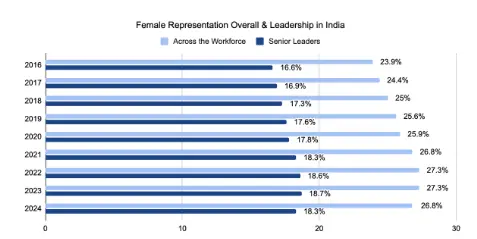
- Women in Leadership Lowest, Moderate and Highest in Sectors:
- Lowest Representation: Construction, Oil, Gas, and Mining, and Utilities (11%), Wholesale and Manufacturing(12%), and Accommodation and Food Services (15%).
- Slightly Better (12%): Wholesale, Manufacturing
- Moderate Representation: Technology, Information & Media, Financial Services (19%)
- Highest Representation: Education (30%) and Government Administration (29%)
- Break the Law:
- Reports indicate non-compliance with laws like the Companies Act, 2013, requiring women directors on company boards. Between April 2018 and December 2023, 507 companies faced fines for violating this mandate, with 90% being listed companies.
India Employment Report 2024 by the International Labour Organization (ILO):
- According to the 2024 India Employment Report by the International Labour Organization (ILO), the female labour force participation rate in India stood at 24.5%, slightly up from 23.3% in 2019, but still below the global average of 47.2%.
- Women in India are predominantly engaged in informal sector jobs, with 86% employed informally compared to 82% of men.
- The Covid-19 pandemic has disproportionately affected women’s employment, with women being 1.8 times more likely to lose their jobs compared to men. The labour force participation rate encompasses individuals aged 16-64 actively employed or seeking employment, excluding those in education, homemakers, and individuals above 64 years of age.
Factors Contributing to Lower Representation of Women in Corporates:
- Gender Bias in Recruitment: Gender bias in recruitment processes hinders women’s entry into corporate roles. According to Catalyst, only 40% of entry-level corporate positions are filled by women.
- Glass Ceiling Phenomenon: The “glass ceiling” effect limits women’s advancement to higher corporate positions. A survey by McKinsey found that only 16% of C-suite positions in India are held by women.
- Work-Life Balance Challenges: Women face challenges balancing work and family responsibilities, which can hinder career progression. Report to the International Labour Organization (ILO) shows that women in India spend 352 minutes per day on unpaid care work, compared to 51 minutes for men.
- Lack of Mentorship and Networking Opportunities: Women often lack access to mentorship and networking opportunities critical for career advancement. A survey by Leaning. Org and McKinsey found that women in India are 24% less likely than men to have had a formal interaction with a senior leader.
- Gender Pay Gap: The gender pay gap persists in India, with women earning significantly less than their male counterparts. According to the World Economic Forum’s Global Gender Gap Report 2023, India ranks 140th out of 156 countries in terms of wage equality for similar work.
- Cultural and Societal Norms: Traditional gender roles and societal expectations often discourage women from pursuing ambitious career paths. A survey by the World Bank found that only 26% of Indian women participate in the labour force, compared to 80% of men.
- Lack of Representation in Leadership Positions: According to the Confederation of Indian Industry (CII), women hold only 6% of board seats in listed companies in India and it creates a lack of role models and discourages aspiring female professionals.
Measures to Enhance Gender Diversity in Corporate Leadership:
- Flexible or Hybrid Work Policies: Implementing flexible or hybrid work policies is crucial for retaining women, particularly at junior and middle management levels, enabling them to balance career aspirations and family commitments effectively.
- Skills-First Approach to Hiring: Adopting a ‘skills-first’ approach to hiring can reduce biases and promote meritocracy by focusing on candidates’ relevant skills, qualifications, and experience rather than gender-based stereotypes.
- Promoting Diversity in Senior Leadership: Government initiatives can promote diversity in senior leadership, such as raising awareness of board diversity in listed companies, as seen in Japan’s “Nadeshiko Brands” program, highlighting companies that empower women’s leadership.
- Establishing Networking and Support Groups for Women: Creating strong networking and support groups for women professionals fosters connections, collaboration, and empowerment, facilitating their journey to leadership through peer learning and mentorship opportunities.
- Mentorship and Networking Opportunities: Providing mentorship and networking opportunities for women enhances their career advancement by enabling experienced female leaders to guide and support aspiring women, sharing insights and strategies.
- Shared Parental Leave Policies: Implementing shared parental leave policies, including paid paternity leave in the private sector, promotes a more equitable distribution of caregiving responsibilities between men and women, supporting gender equality in the workforce.
Conclusion
Hence, the stagnation in the representation of women in corporate leadership roles in India is a concerning trend that demands immediate attention. By addressing this issue and implementing such measures, we can enhance gender diversity and unlock the full potential of women in the corporate sector, fostering a more inclusive and equitable workplace for all.
UPSC Civil Services Examination, Previous Year Questions (PYQs)
Prelims
Q. Disguised unemployment generally means (2013)
(a) large number of people remain unemployed
(b) alternative employment is not available
(c) marginal productivity of labour is zero
(d) productivity of workers is low
Ans: (c)
Mains
Q. Most of the unemployment in India is structural in nature. Examine the methodology adopted to compute unemployment in the country and suggest improvements. (2023)
Tobacco epidemic in India
Tag: GS-2- Social issues- Government Policies & Interventions GS-3- Health
In News:
- India has the world’s second-highest (after China) number of tobacco consumers, with nearly 26 crore people and 1.35 million die every year due to use of tobacco.
- In the fiscal year 2017-2018, the health consequences of tobacco consumption imposed a financial burden of more than ₹1.7 lakh crore on India, surpassing the health budget of ₹48,000 crore for that period.
- Moreover, addressing tobacco waste incurs approximately ₹6,367 crore annually, excluding expenses related to soil erosion and deforestation.
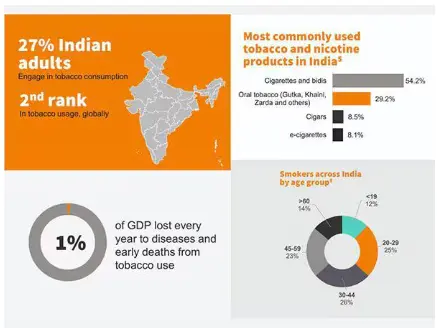
The Statistics in Curbing Tobacco Consumption:
- Ineffectiveness of NTCP: Studies indicate no significant difference in reducing bidi or cigarette consumption between NTCP and non-NTCP districts, attributed to factors like inadequate staffing, resource allocation, and monitoring mechanisms.
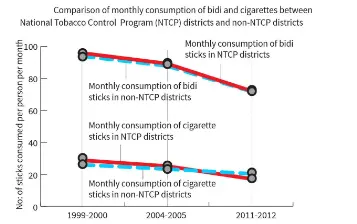
- Tax Evasion: Tax evasion, including purchasing tobacco in low-tax areas and illegal activities like smuggling, undermines government efforts. Low tobacco taxes, compared to recommendations, have contributed to affordability.
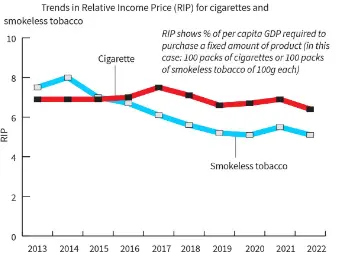
- Tobacco Use Higher Among Womens: Tobacco use has declined in all groups, except for women where use increased by 2.1% between 2015 and 2021.
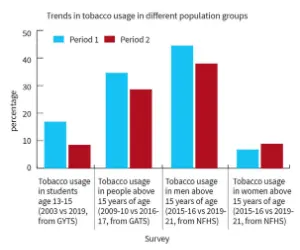
Impact of Tobacco Beyond Health Risks:
- Soil Depletion: Tobacco rapidly depletes soil nutrients, necessitating increased use of fertilisers which further degrade soil quality.
- Deforestation: Tobacco production contributes to deforestation, with up to 5.4 kg of wood required to process 1 kg of tobacco.
- Waste Generation: The production and consumption of tobacco generate massive waste, totalling 1.7 lakh tonnes annually in India.
- Economic Burden: Tobacco use incurs immense healthcare costs, with an estimated loss of Rs.1.7 lakh crore in India (2017-18), surpassing the national health budget of Rs.48,000 crore.
- Health Risks for Workers: Over 6 million people working in the tobacco industry are at risk of health issues due to tobacco absorption through the skin.
- Waste Management Cost: Cleaning up tobacco waste imposes significant additional costs, estimated at Rs.6,367 crore annually in India
Measures and Initiatives to Address Tobacco Consumption:
- Framework Convention on Tobacco Control (FCTC): Launched in 2005, the FCTC aims to reduce global tobacco usage by assisting nations in developing strategies for demand and supply reduction.
- Implementation of COTPA Act, 2003: The COTPA Act, enacted in 2003, regulates the production, advertisement, distribution, and consumption of tobacco products, aiming to prohibit ads and regulate tobacco trade.
- National Tobacco Control Programme (NTCP): India initiated the NTCP in 2007 to enhance the implementation of COTPA and FCTC, increase awareness about tobacco’s harmful effects, and facilitate tobacco cessation.
- Tobacco Taxation: Tobacco taxation, considered a potent tool globally to curb tobacco use, is also applied in India.
Strategies for Future Action
- Strengthening Enforcement of Existing Laws: Stricter enforcement of laws like COTPA, PECA, and NTCP is imperative to control tobacco usage effectively.
- Revision of Tobacco Taxes: Increasing tobacco taxes to align with international recommendations, inflation, and economic growth can deter consumption and generate revenue.
- Diversification of Agriculture: Assisting tobacco farmers in transitioning to alternative crops can mitigate job losses and promote sustainable agriculture.
- Data Collection and Monitoring: Regular and comprehensive data collection on tobacco use is essential to counter industry tactics and formulate effective control measures.
UPSC Civil Services Examination, Previous Year Questions (PYQs)
Prelims:
Q:1 Consider the following: (2012)
- Assessment of land revenue based on nature of the soil and the quality of crops
- Use of mobile cannons in warfare
- Cultivation of tobacco and red chillies
Which of the above was/were introduced into India by the English?
(a) 1 only
(b) 1 and 2
(c) 2 and 3
(d) None
Ans: (d)
Q:2 Match List-I with List-II and select the correct answer using the code given below the Lists: (2008)
List-I(Board) List-II (Headquarters)
A. Coffee Board 1. Bengaluru
B. Rubber Board 2. Guntur
C. Tea Board 3. Kottayam
D. Tobacco Board 4. Kolkata
Code:
A B C D
(a) 2 4 3 1
(b) 1 3 4 2
(c) 2 3 4 1
(d) 1 4 3 2
Ans: (b)
Q:3 Which of the following are the reasons/factors for exposure to benzene pollution? (2020)
- Automobile exhaust
- Tobacco smoke
- Wood burning
- Using varnished wooden furniture
- Using products made of polyurethane
Select the correct answer using the code given below:
(a) 1, 2 and 3 only
(b) 2 and 4 only
(c) 1, 3 and 4 only
(d) 1, 2, 3, 4 and 5
Ans: (a)
Q:4 Which one of the following groups of plants was domesticated in the ‘New World’ and introduced into the ‘Old World’? (2019)
(a) Tobacco, cocoa and rubber
(b) Tobacco, cotton and rubber
(c) Cotton, coffee and sugarcane
(d) Rubber, coffee and wheat
Ans: (a)
Source: TH
Flight Turbulence And Climate Change
Tag: GS-3, Ecology & Environment – Impact of Climate Change on Flight Turbulence
In News:
- Following an incident where a Singapore Airlines flight from London to Singapore experienced sudden and severe turbulence over Myanmar, a Qatar Airways flight from Doha to Dublin encountered severe turbulence over Turkey.
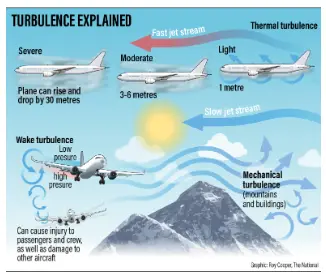
Flight Turbulence:
- Flight turbulence refers to irregular motion of the air caused by eddies and vertical currents.
- It can range from minor bumps to severe disturbances capable of causing structural damage or loss of control in an aircraft.
- Turbulence often occurs near fronts, wind shear, thunderstorms, and other atmospheric disturbances.
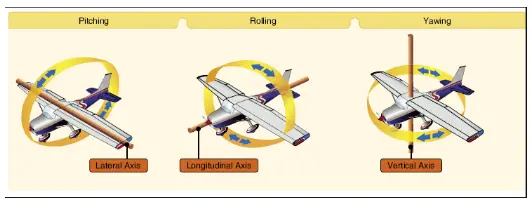
Types of Flight Turbulence
- Light Turbulence: This type of turbulence causes slight changes in altitude resulting in minor bumpiness, typically manageable by the aircraft.
- Moderate Turbulence: Aircraft may experience more noticeable changes in altitude and attitude during moderate turbulence, but the plane remains under control.
- Severe Turbulence: Significant and sudden changes in altitude and attitude occur during severe turbulence, occasionally causing the aircraft to momentarily lose control.
- Extreme Turbulence: In extreme turbulence, the aircraft is violently tossed about, making it practically impossible to control.
Causes of Flight Turbulence
- Mechanical Turbulence: Results from friction between air and the ground, particularly over irregular terrain and man-made obstacles, leading to the formation of eddies.
- Convective or Thermal Turbulence: Caused by rapid rising of hot air from certain ground surfaces, creating convective air currents as cooler air descends.
- Frontal Turbulence: Occurs due to friction between opposing air masses and the lifting of warm air by sloping frontal surfaces, commonly found near thunderstorms.
- Wind Shear: Change in wind direction or speed over a specific horizontal or vertical distance, often observed in temperature inversion areas and around jet streams.
- Clear Air Turbulence (CAT): Sudden and severe turbulence occurring without visible weather cues, considered a type of wind shear turbulence.
Impact of Climate Change on Flight Turbulence:
- Increased Incidence: A study by the University of Reading found that severe turbulence incidents over the North Atlantic flight routes have increased by 55% from 1979 to 2020, primarily due to climate change.
- Jet Stream Intensification: Enhanced jet streams, driven by climate change, have led to more intense turbulence. In 2019, 24% flights experienced unexpected severe turbulence over the Pacific Ocean, causing injuries to passengers and crew.
- Mountain Wave and Near-Cloud Turbulence: In regions like the Rocky Mountains and the Himalayas, pilots have reported an increase in mountain wave turbulence.
Way Forward:
- Safety Measures: Continuous improvements in aircraft design can help mitigate turbulence risks. Enhanced weather forecasting technologies can better predict turbulence.
- Passenger Advice: Passengers are advised to keep their seat belts fastened as much as possible to avoid injuries during unexpected turbulence.
- Regulatory Recommendations: Aviation authorities recommend better communication and real-time information sharing between pilots and air traffic control. Enhanced training for pilots and crew to prevent and manage turbulence-related incidents.
Source: TH
Diadromous Fish
Tag: GS-3- Ecology & Environment- Biodiversity- Species
In News:
- A study published in the British Ecological Society’s Journal of Applied Ecology found that Marine Protected Areas (MPAs) designated to protect diadromous fish species do not align with their core habitats.
- The study focused on 11 rare and poorly documented diadromous fish species that migrate between saltwater and freshwater environments.
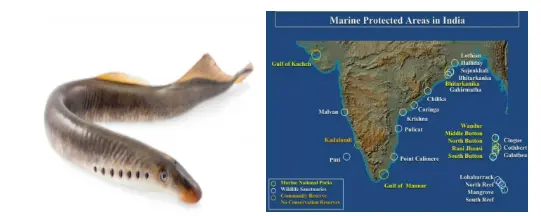
Key Highlights of the Study about Diadromous Fish Species:
- Habitat Overlap with MPAs: Only 55% of the modelled core habitats for these species overlapped with designated Marine Protected Areas (MPAs).
- Protection Measures: Of the MPAs that did overlap, only 50% had specific measures in place to protect the fish species.
- Endangered Species Protection: Less than 30% of endangered species, such as the Mediterranean twaite shad, had their core habitats within MPAs.
- High Overlap Species: Species like the European eel and European smelt had nearly 70% of their core habitats within MPAs
Categories of Diadromous fishes:
- Anadromous Fish: These fish are born in freshwater, migrate to the ocean as juveniles to mature, and then return to freshwater to spawn. Examples: salmon, trout, and shad.
- Catadromous Fish: These fish are born in saltwater, migrate into freshwater as juveniles to grow, and then return to the ocean to spawn.Example: Eel.
- Amphidromous Fish: These fish are born in freshwater or estuaries, drift into the ocean as larvae, and then migrate back to freshwater to mature and spawn.Example: Gobies and gudgeons.
- Potamodromous Fish: These fish are born in upstream freshwater habitats, migrate downstream (still in freshwater) as juveniles to grow, and then return upstream to spawn. Examples: Catfish, Salmon, Colorado.
Challenges Faced by Diadromous Fish:
- Sensitivity to Anthropogenic Pressures: Diadromous fish are highly sensitive to agricultural and pollutant runoffs, habitat destruction, barriers to migration, fishing, bycatch, and climate change.
- Migration Barriers: Dams, weirs, and locks significantly impact these fish, obstructing their movement between freshwater and marine habitats essential for their life cycle.
Threats to Diadromous Fish:
- Agricultural and pollutant runoffs: Contaminants from agriculture and other sources can harm their habitats.
- Habitat destruction: Dam construction and land development impact their migration routes.
- Barriers to migration: Dams, weirs, and other structures hinder their movement.
- Fishing and bycatch: Overfishing and accidental capture affect their populations.
- Climate change: Altered water temperatures and habitats impact their survival.
UPSC Civil Services Examination Previous Year Question (PYQ)
Q:1 Recently, our scientists have discovered a new and distinct species of banana plant which attains a height of about 11 metres and has orange coloured fruit pulp. In which part of India has it been discovered? (2016)
(a) Andaman Islands
(b) Anaimalai Forests
(c) Maikala Hills
(d) Tropical rain forests of northeast
Ans: (a)
Source: DTE
Red Flag 24 Exercise
Tag: GS-3 – Science & technology- Defence
In News:
- Recently, an Indian Air Force (IAF) contingent arrived at the Eielson Air Force Base in Alaska to take part in the esteemed multinational exercise, Red Flag 24.
- Supported by IL-78 air-to-air refuelers and the C-17 transport aircraft, the IAF Rafale fighters undertook a transatlantic flight.
- They made staging halts in Greece and Portugal before reaching their destination.

How does it work?
- Participants in RED FLAG-Alaska are divided into: 1.”Red” defensive forces 2.”Blue” offensive forces. 3.”White” forces serving as a neutral controlling agency.
- The defensive forces include ground-control intercept and surface air defence units to replicate potential threats from hostile nations.
- They employ defensive counter-air tactics under ground-control intercept guidance.
Participation and Objectives:
- The Indian Air Force (IAF) has deployed Rafale fighter jets for participation in the Red Flag 24 exercise.
- The exercises adapt to diverse forces within a realistic threat environment, utilising over 77,000 square miles of airspace in the Joint Pacific Alaska Range Complex, the world’s largest combat training range.
- Red Flag is a two-week advanced aerial combat training exercise.
- It aims to integrate aircrew in a multinational environment.
- It joins forces with other international participants to enhance their combat readiness and interoperability.
Exercise Location and Management:
- Eielson Air Force Base, located just 40 km from the town of Fairbanks, will serve as the hub for this multinational collaboration.
- The base is home to a squadron of F-16 Fighting Falcons and two squadrons of the United States Air Forces’ (USAF) F-35s.
- The exercise is managed by the 353rd Combat Training Squadron based at Eielson AFB,
Historical Background:
- RED FLAG-Alaska is an exercise sponsored by Pacific Air Forces, initially named COPE THUNDER.
- It was relocated to Eielson AFB from Clark Air Base, Philippines, in 1992 due to the eruption of Mount Pinatubo.
- COPE THUNDER was later renamed RED FLAG-Alaska in
- Beginning in 1976, COPE THUNDER was created to provide aircrews with simulated combat training.
- It evolved into PACAF’s primary exercise for airpower employment.
Source: TH
Cryonics
Tag: GS-3 Science and Tech- Biotechnology
In News:
A cryonics company in Australia has frozen its first client, hoping to revive him in the future.
Understanding Cryonics:
- Cryonics is the practice of freezing a deceased individual with the aim of reviving them in the future.
- The term “cryonics” originates from the Greek word “krýos,” which means “icy cold.”
- This method seeks to save lives by preserving individuals at extremely low temperatures, enabling future medical technology to restore them to full health, even if current medicine cannot help them.
Concept and Terminology:
- Individuals preserved through cryonics are referred to as “cryopreserved patients” because proponents, known as Cryonicists, do not consider them truly dead.
- Cryonic preservation can only occur after a person has been legally declared dead.
Process of Cryonic Preservation:
- The procedure begins shortly after death, with the body being packed in ice and transported to a cryonics facility.
- At the facility, blood is drained from the body and replaced with antifreeze and organ-preserving compounds called cryoprotective agents.
- In this vitrified state, the body is placed in a chamber filled with liquid nitrogen, maintaining a temperature of -196 °C.
- The body remains preserved in this state until scientists develop the means to revive it in the future.
Ethical Considerations:
- Consent: Individuals must provide informed consent prior to death for cryonic preservation.
- Ethical Debates: Concerns about identity and continuity, the potential for future resuscitation, and resource allocation.
Source: NDTV
External Commercial Borrowings (ECBs)
Tag: GS-3 Economy- RBI- External Commercial Borrowings (ECBs)
In News:
- According to data from the RBI, registrations by Indian companies for external commercial borrowings (ECBs) nearly doubled in the financial year 2023-24 (FY24), reaching $49.2 billion compared to $26.6 billion in FY23.
About External Commercial Borrowings (ECBs):
- External Commercial Borrowings (ECBs) refer to the borrowing of funds by Indian companies from foreign sources through loans, bonds, or other financial instruments.
Purpose:
- ECBs can finance various activities, including business expansion, asset acquisition, and debt repayment.
Sources of ECBs:
- ECBs can be obtained from foreign banks, international financial institutions, and foreign subsidiaries of Indian companies.
- ECBs can be rupee-denominated (repaid in Indian rupees) or foreign currency-denominated (repaid in a foreign currency).
Regulation:
- The Reserve Bank of India (RBI) regulates ECBs, setting limits on the amount and usage of funds.
- ECBs must comply with RBI regulations under the Master Direction – External Commercial Borrowings, Trade Credits, and Structured Obligations (Master Direction), and the Foreign Exchange Management Act, 1999 (FEMA).
- ECBs must meet criteria such as minimum maturity period, maximum all-in-cost ceiling, and permitted and non-permitted end-uses.
Routes to Raise ECBs:
- Automatic Route: Companies that meet eligibility criteria set by the government can raise funds without needing approval. Eligibility criteria relate to the amount, industry, and end-use of funds.
- Approval Route: Companies in certain specified sectors must obtain explicit permission from the RBI or the government before raising funds through ECBs.
- Eligibility: All entities, except Limited Liability Partnerships, are allowed to raise ECBs under RBI guidelines.
Benefits:
- Opportunity to borrow large volumes of funds.
- Availability of funds for a relatively long term.
- Lower interest rates compared to domestic funds.
- Access to foreign currency to meet import requirements, such as machinery.
Risks:
- Exchange Rate Risk: Fluctuations in the value of the Indian rupee against foreign currencies can affect the cost of repaying the loan.
- Sovereign Risk: The creditworthiness of foreign lenders can be influenced by the ability of a foreign government to repay its debt.
- Credit Risk: Foreign lenders may not have the same level of protection as domestic lenders in the event of default.
- Regulatory Risk: Changes in government regulations or policies related to ECBs can affect the availability and cost of borrowing.
UPSC Civil Services examination PYQ
Prelims:
Q:1 Consider the following statements: (UPSC Prelims-2019)
- Most of India’s external debt is owed by government entities.
- All of India’s external debt is denominated in US dollars.
Which of the statements given above is/are correct?(a) 1 only(b) 2 only(c) Both 1 and 2(d) Neither 1 nor 2
Answer: (d)
Source: BS
Frequently Asked Questions (FAQs)
Q: What are daily current affairs?
A: Daily current affairs refer to the most recent and relevant events, developments, and news stories that are happening around the world on a day-to-day basis. These can encompass a wide range of topics, including politics, economics, science, technology, sports, and more.
Q: Why is it important to stay updated with daily current affairs?
A: Staying updated with daily current affairs is crucial because it helps individuals make informed decisions in their personal and professional lives. It enables people to understand the world around them, stay aware of significant events, and engage in informed discussions about important issues.
Q: Where can I access daily current affairs information?
A: There are various sources for daily current affairs, including newspapers, news websites, television news broadcasts, radio programs, and dedicated apps or newsletters. Social media platforms are also widely used to share and access current affairs information.
Q: How can I effectively incorporate daily current affairs into my routine?
A: To incorporate daily current affairs into your routine, consider setting aside specific times each day to read or watch news updates. You can also subscribe to newsletters or follow news apps to receive curated content. Engaging in discussions with peers or participating in online forums can further enhance your understanding of current events.
Q: What are some tips for critical analysis of daily current affairs?
A: When analyzing daily current affairs, it’s essential to cross-reference information from multiple sources to ensure accuracy. Additionally, consider the source’s credibility and bias, if any. Develop the ability to identify the main points and implications of news stories, and critically evaluate the significance and impact of the events reported.
In case you still have doubts, contact us on 9811333901.
For UPSC Prelims Resources, Click here
For Daily Updates and Study Material:
Join our Telegram Channel – Edukemy for IAS
- 1. Learn through Videos – here
- 2. Be Exam Ready by Practicing Daily MCQs – here
- 3. Daily Newsletter – Get all your Current Affairs Covered – here
- 4. Mains Answer Writing Practice – here

